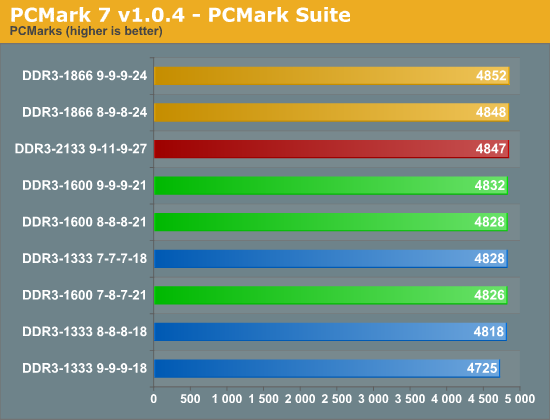Sandy Bridge Memory Scaling: Choosing the Best DDR3
by Jared Bell on July 25, 2011 1:55 AM ESTLINPACK Benchmark
At first I wasn't going to include the results of the LINPACK benchmark, but I figured there's no reason for them to go to waste as they were used for stability testing. The LINPACK benchmark is a measurement of a system's floating-point computing power. Today, it's widely used by enthusiasts for testing the stability of their overclocked systems. The later versions of LINPACK include support for Intel's AVX instruction set, which stress the CPU and RAM even more than before. We'll be using a front end to the LINPACK benchmark called LinX.

Now we begin to see how that extra ~36% of bandwidth really affects system performance. As you can see, there's not exactly a ~36% advantage in LINPACK from the fastest to the slowest. Here, we're barely seeing a ~3% advantage for the faster memory. Once we get to DDR3-1600, there's not much of a difference at all.
PCMark 7
We'll measure overall system performance using the PCMark suite. This will perform a broad range of tests including video playback, video transcoding (downscaling), system storage (gaming), graphics (DX9), image manipulation, system storage (importing pictures), web browsing, data decrypting, and system storage (Windows Defender).

If you take a step back and look at performance from an overall perspective, you can see that faster memory doesn't really have much of an effect. Every speed tested shows a ~2% performance increase over the slowest memory. Outside of CAS 9 DDR3-1333, then, you can pretty much use any DDR3 memory and get close to optimal performance in general applications.










76 Comments
View All Comments
mga318 - Monday, July 25, 2011 - link
You mentioned Llano at the end, but in the Llano reviews & tests, memory bandwidth was tested primarily with little reference to latency. I'd be curious as to which is more important with a higher performance IGP like Llano's. Would CAS 7 (or 6) be preferrable over 1866 or 2166 speeds wtih CAS 8 or 9?DarkUltra - Monday, July 25, 2011 - link
How about testing Valves particle benchmark or a source based game at low reslution with a non-geometry limited 3d card (fermi) and overclocked cpu? Valve did an incredible job with their game engine. They used a combination of fine-grained and coarse threading to max out all the cpu cores. Very few games can do that today, but may in the future.DarkUltra - Monday, July 25, 2011 - link
Why test with 4GB? RAM is cheap, most people who buy the premium 2600K should pair it with two 4GB modules. I imagine Windows would require 4GB ram and games the same in the future. Just look at all the .net developers out there, .net usually results in incredible memory bloated programs.dingetje - Monday, July 25, 2011 - link
hehe yeah.net sucks
Atom1 - Monday, July 25, 2011 - link
Most algorithms on CPU platform are optimized to have their data 99% of time inside the CPU cache. If you look at the SisSoft Sandra where there is a chart of bandwidth as a function of block size copied you can see that CPU cache is 10-50x faster than global memory depending on the level. Linpack here is no exception. The primary reason for success of linpack is its ability to have data in CPU cache nearly all of the time. Therefore, if you do find an algorithm which can benefit considerably from global memory bandwidth, you can be sure it is a poor job on the programmers side. I think it is a kind of a challenge to see which operations and applications do take a hit when the main memory is 2x faster or 2x slower. I would be interested to see where is the breaking point, when even well written software starts to take a hit.DanNeely - Monday, July 25, 2011 - link
That's only true for benchmarks and highly computationally intensive apps (and even there many problem classes can't be packed into the cache or written to stream data into it). In the real world where 99% of software's performance is bound by network IO, HD IO, or user input trying to tune data to maximize the CPU cache is wasted engineering effort. This is why most line of business is written using java or .net, not C++; the finer grained memory control of the latter doesn't benefit anything while the higher level nature of the former allows for significantly faster development.Rick83 - Monday, July 25, 2011 - link
I think image editing (simple computation on large datasets) and engineering software (numerical simulations) are two types of application that benefit more than average from memory bandwidth, and in the second case, latency.But, yeah, with CPU caches reaching the tens of Megabytes, Memory bandwidth and latency is getting less important for many problems.
MrSpadge - Wednesday, July 27, 2011 - link
True.. large matrix operations love bandwidth and low latency never hurts. I've seen ~13% speedup on part of my Matlab code going from DDR3-1333 CL9 to DDR3-1600 CL9 on an i7 870!MrS
Patrick Wolf - Monday, July 25, 2011 - link
You don't test CPU gaming benchmarks at normal settings cause you may become GPU limited so why do it here?http://www.xbitlabs.com/articles/memory/display/sa...
dsheffie - Monday, July 25, 2011 - link
....uh...Linpack is just LU which in turn is just DGEMM. DGEMM has incredible operand reuse (O(sqrt(cache size)).